The Brush of Woodward
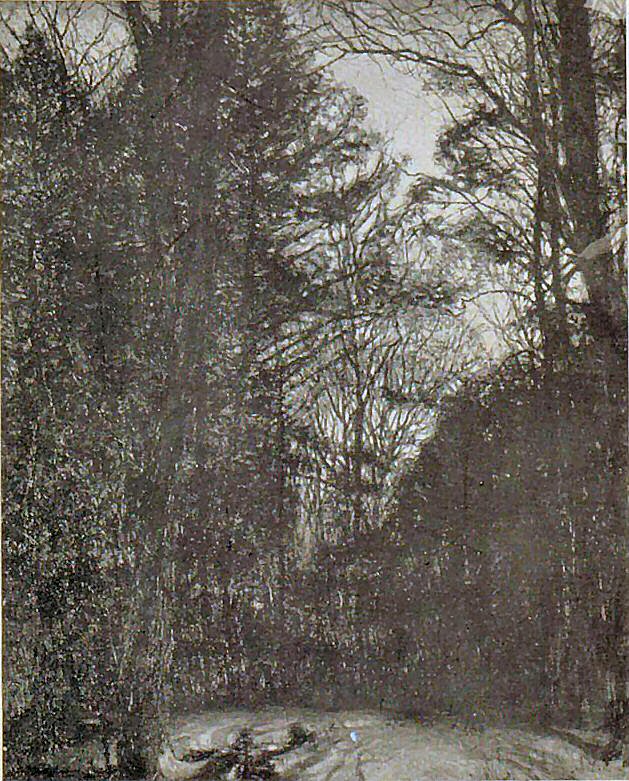
 Between Setting Sun and Rising Moon (1918- '19)
Between Setting Sun and Rising Moon (1918- '19)
RSW Brush Technique: Early Career
As every artist does, Woodward's painting technique matured over time. He did not start working with oil until the age of 31 (1916), when he had come to the conclusion that a career in illustration was not supplying the necessary means for him to comfortably support himself. It is told by close friend Clifton Richmond that one day RSW found a grey hair and realized he would have to begin his dream of becoming a landscape artist soon or it would be too late. It was a bold move, given he was unable to complete any significant formal training (a brief stint at the BMFA School in Boston proved too difficult given his disability and the school's lack of accessibility suited to his needs). Though naturally gifted with artistic ability, there is far more than meets the eye when it comes to the proper mixture and preservation of the oils set to canvas. He expressed as much in an entry to his painting diary regarding his Hallgarten Prize winning painting (1919) Between Setting Sun and Rising Moon, stating,
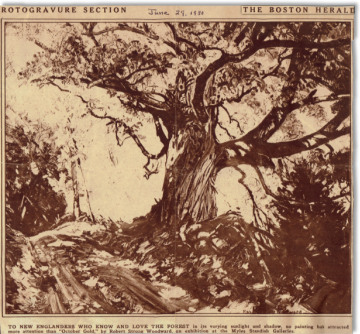
 Boston Herald, Rotogravure Section
featuring
Boston Herald, Rotogravure Section
featuring
October Gold which would be purchased by collector
Josephine Everett and later donated to
the Pasadena
Museum of Fine Art. For a number of years, its location
was believed to be known until it was presented to us
by its current owner that there ARE two paintings!
"Have heard nothing of the canvas in recent years and fear it may have darkened or cracked, as I was not aware of the proper mediums to use for lasting results in those days. Feel badly about this possibility."
A number of his early paintings did just that, both darkened and cracked. Recently the estate took one of his early paintings to be repaired and restored and the restorer showed us a number of examples on the canvas where RSW 'mixed' his oils differently and it was clearly visible that he was experimenting and learning through trial and error. One critic, early in his career noted in a review of his work that, 'you can see his progression in each of his paintings so much so that one would be able to line them up in order.' The early success in his career put him in contact with other more experience artist, some of which he became close friends with, such as, Gardner Symons and Chauncy Ryder, who most assuredly lent their knowledge and guidence to his education and growth in these matters.
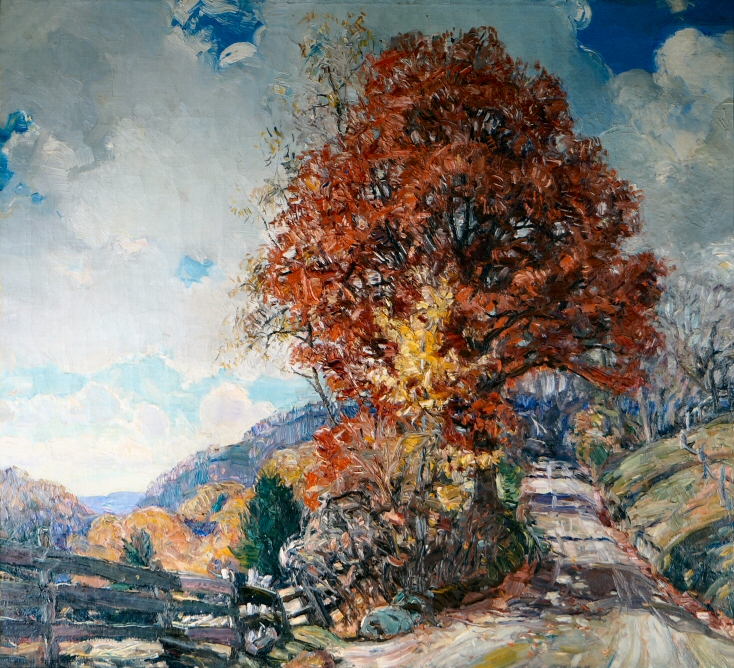
 Autumn Brilliance, (1925) one of the best
Autumn Brilliance, (1925) one of the best
examples we have of RSW's impasto style
Besides the issues related to working with the oil medium, there is also the technique of applying the oil to the canvas itself. Woodward's early-career brush technique is best described as 'impasto' which is; where paint is laid in a very thick layering, usually thick enough to see the brush or knife strokes. To our knowledge, RSW never used a knife or spatula to apply his paint, however, you can clearly see his brush. There is some argument among us as to whether this technique was a conscious choice of Woodward to use this technique as a matter of painting in the style of the Impressionist. While this is certainly possible, I find it much more likely that Woodward started out in a form that was more 'abstract' because it is an easier and a more forgiving method. The method of blending and layering his strokes (as well as properly mixing his paints to dry and blend accordingly at the rates he needed to produce the look he intends to achieve) in order to aquire the fine and meticulously detailed style equal to the natural realism he would become known for, would take years of development and evolution.
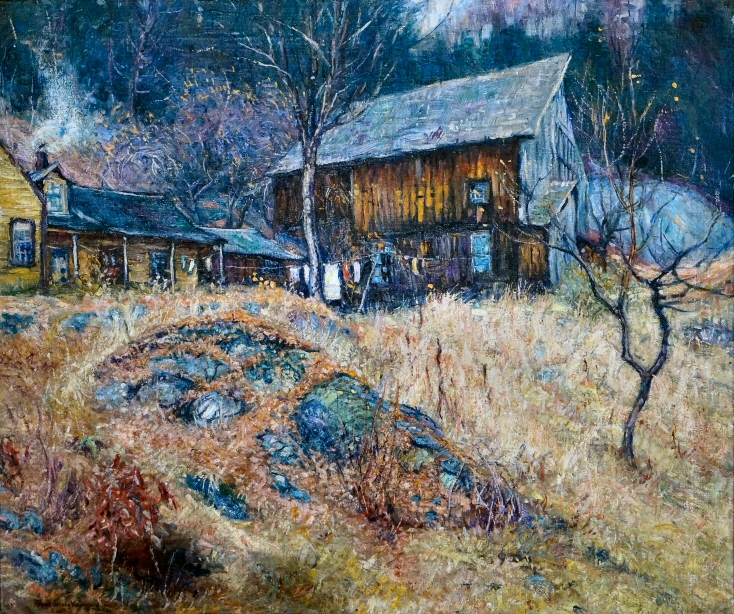
 The Golden Barn (1918)
The Golden Barn (1918)
This impasto style served Woodward well early in his career because it was more fashionable at the time. The American Scene Painting movement, (which grew out of a sentiment that rejected the more traditional idealized and romantic European-styled paintings) for which he is best known would not gain traction for another 7 years. RSW would benefit from the first seeds of the movement taking hold through several organizations, such as the Boston Art Club, to loosening its stringent policies toward exhibiting only traditional art. Two years after Woodward began painting in oil, the Boston Art Club held its first ever exhibition solely for New England Artist. I cannot even begin to describe how controversial this was, for more details please see our related Scrapbook page 1918, Paintings of New England Artist exhibition page. Nonetheless, Woodward found his foot in the door exhibiting two paintings which was widely praised in the Boston papers. He would follow up that exhibition by entering his painting The Golden Barn in the National Academy's annual exhibition in NYC. The very next year he would win the Hallagarten Prize.
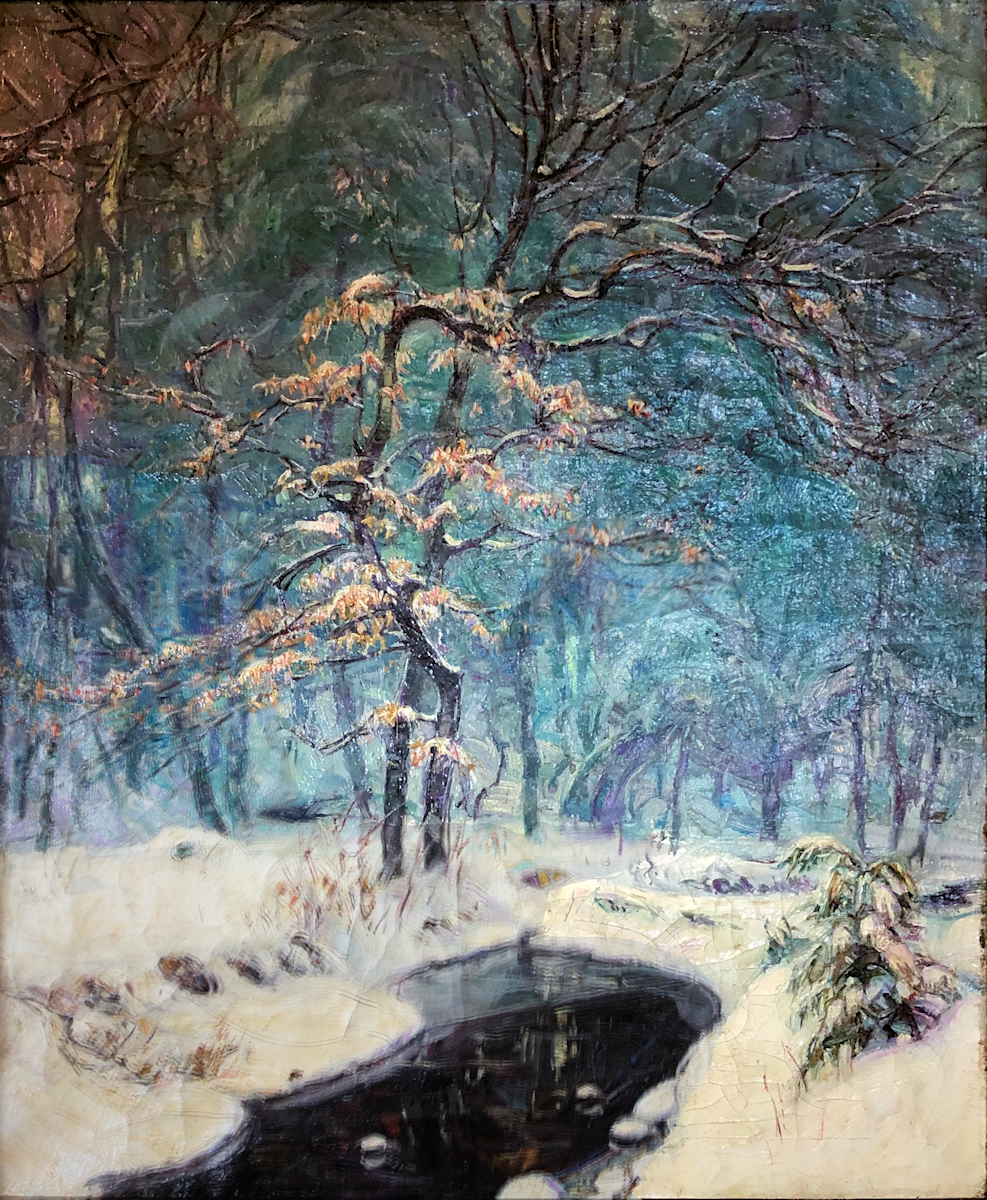
 Winter Mist (1920- '21), a classic
Winter Mist (1920- '21), a classic
example of RSW's 'moonlit woods'
This early success, particularly Between Setting Sun and Rising Moon's, high praise would lead RSW paint a series of similar "moonlit woodland canvases" we affectionately call Quintessential Redgate paintings in reference to his first studio from which he often looked just out his backdoor to paint. These paintings are an anomaly to RSW's catalogue of work. While they hold true to his sense of depicting a level of realism, they are highly stylized and atmospheric. A great contrast to the style in which RSW would be most remembered. There are a number of different theories as to what prompted him, but the prevailing one is simple economics... they were fashionable, popular and selling well. They also reveal some insight to his state of mind at the time with their, 'can't see the forrest through the trees,' feel to them. He really was just finding his way in the dark. Fortunately for us, there always appeared to be a light at the end of the tunnel.
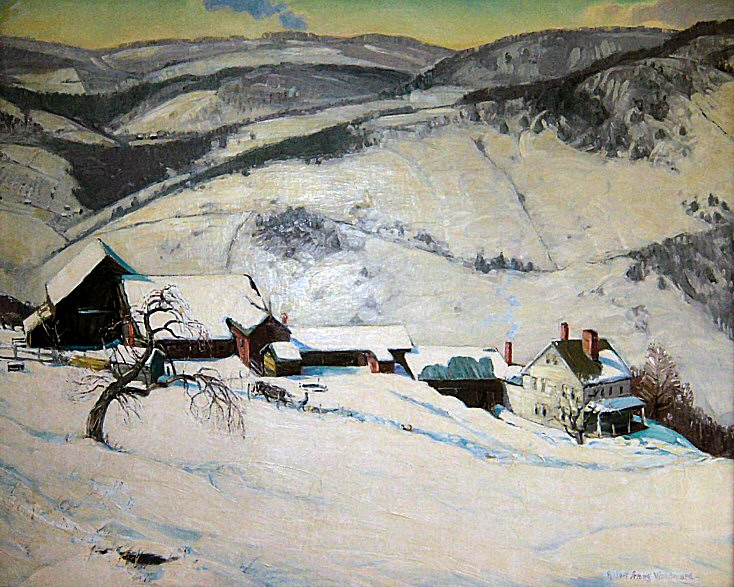
 New England Drama (1930)
New England Drama (1930)
The appetite for more modern 'American' style of art becoming fashionable first showed itself in Woodward's first major One-Man Show held at the residence of Boston socialite Ronald Lyman in 1926. Of the twenty-three paintings exhibited, far more of Woodward's natural scenery paintings sold then those of his moonlit woodland canvases (all of which exhibited numerous times afterward). This prompted a conscientious shift in focus by Woodward to concentrate his work on what better suited his natural leanings towards the exploration of rural New England. It would also force him to develop a more finely tuned method of delicate touches in his brush stroke and blending in order to capture the natural realism of an almost photographic quality compositions. He would leave the atmospheric woods paintings behind for the remander of his career with the only exception being that he kept two Redgate paintings in storage for nearly 20yrs that he was not quite satisfied with and re-painted them in the mid-40's.
The transition in technique and style would not be without its bumps along the way. In 1930, his Boston Tercennitary 'gold medal' winning and widely praised painting, New England Drama, was mildly panned by the renoun critic of the time Royal Cortissoz as being 'painty' throughout its snow filled hills, which naturally piqued Woodward's ire. However, Cortissoz's criticism is not without merit. If one were to examine the painting closely, it is clear that while the foreground landscape and mid-ground farm are painted in fine and delicate detail, the hills of the background show signs of RSW's early technique of impasto. You can literally see the strokes of his brush. From this year on, Woodward would mature into the technique and style he would use throughout the remander of his career.
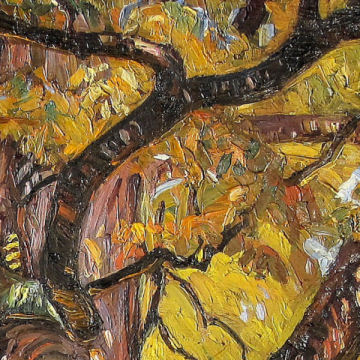
 A close up of An October Gold (prior to 1929).
A close up of An October Gold (prior to 1929).
The brush stroke and texture of impasto clearly visible.
October Gold: The Best Example of the Difference
A number of years back, the owner of a painting with no name contacted us for help in identifying the artwork. Upon using the estate's sepia print collection, we matched the painting to a print titled, October Gold. Though the size of the painting did not match the records we had for October Gold, this was not unusual. Woodward did not begin to compile a record of his paintings in diary form until sometime between 1942 and '45 and he did so almost entirely from memory. It has been found to have a number of inaccuracies, small items, here-n-there. So we saw no reason to believe that this 25 x 30 painting was not the 27 x 30 October Gold, that is until an owner of the other painting contacted us in 2016.
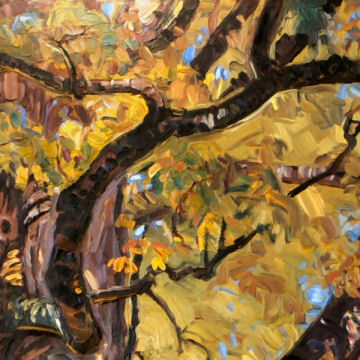
 A close up of October Gold (1929).
A close up of October Gold (1929).
Though you can see the brush strokes,
they are layered and blended
The owner provided us pictures of the painting in their possession, including the back of the stretcher which clearly showed its name October Gold written in pencil. To further prove its case, it measured 27 x 30 and the back of the stretcher held several inventory numbers and labels from its travels. The proof at that point was irrefutable. The question now became, 'What was the other painting of the exact same subject and composition?' It has no name, to mention in the diaries, or the exhibitions list... But upon closer examination, we note a very distinct difference between the two identical paintings; they are painted in different style techniques. The only two paintings in Woodward's entire collection that demostrate, in the clearest way, one style verses the other. It is also why some people mistakenly associate RSW with being an Impressionist, of which he himself never said. In an interview with Harry Elmore Hurd, Art Critic for the periodical, "The Breeze," (1931) noted that RSW, "... chooses a middle course in his technique, avoiding both the too impressionistic and the too detailed."
Hurd, quoting Woodward directly, "Mr. Woodward says..."
"... I have no patience with the so-called ultra-moderns, who defy established technical law and expression and careful craftsmanship and drawing, yet I have no sympathy with the over-studied, polished meticulous academic painting of exact replica. The 'likeness' of a landscape, even if exact, is dead in paint, unless it holds as a picture the spirit and essence and expression of that landscape. I try to paint the feeling of a landscape, the 'emotion' of it, as well as the facts 'this seeming to me a more impressive, lasting and interesting thing than merely the exactly recorded fact alone.'"
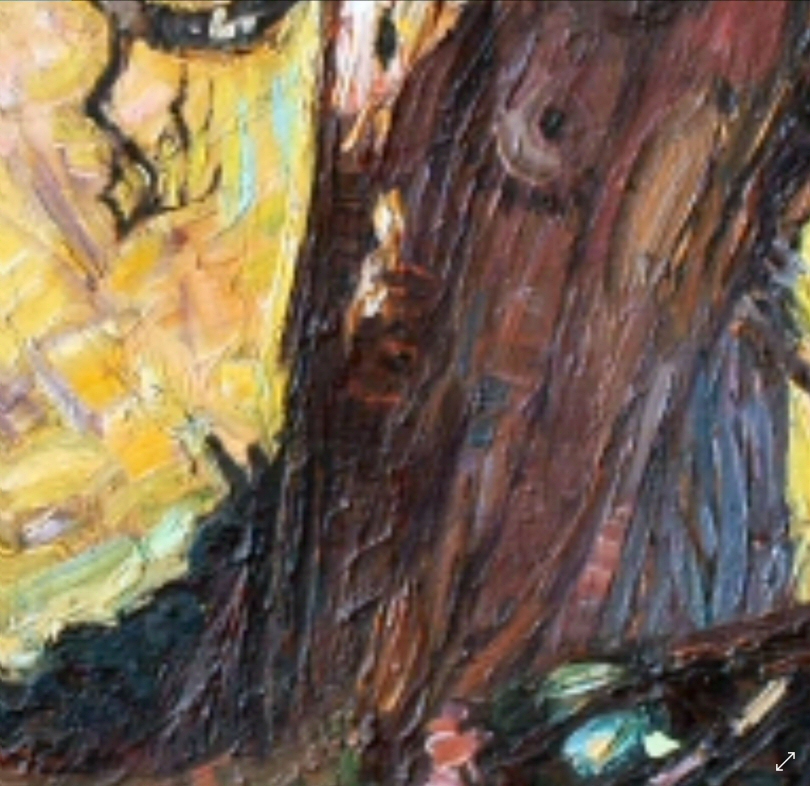
 A close up of An October Gold (prior to 1929),
A close up of An October Gold (prior to 1929),
the impasto style of stroke, has the 'impression'
of reflective light touching the trunk.
The unnamed painting of October Gold (that is now named An October Gold by the website and approved by its current owner) could have been sold directly from RSW's studio which would explain it not having an official name. It is likely that while the painting sat in his studio, Woodward used An October Gold to work on his new and developing technique of blending his brush strokes to attain a more photographic quality, much in the way the eye sees, that is a natural expression of nature itself.
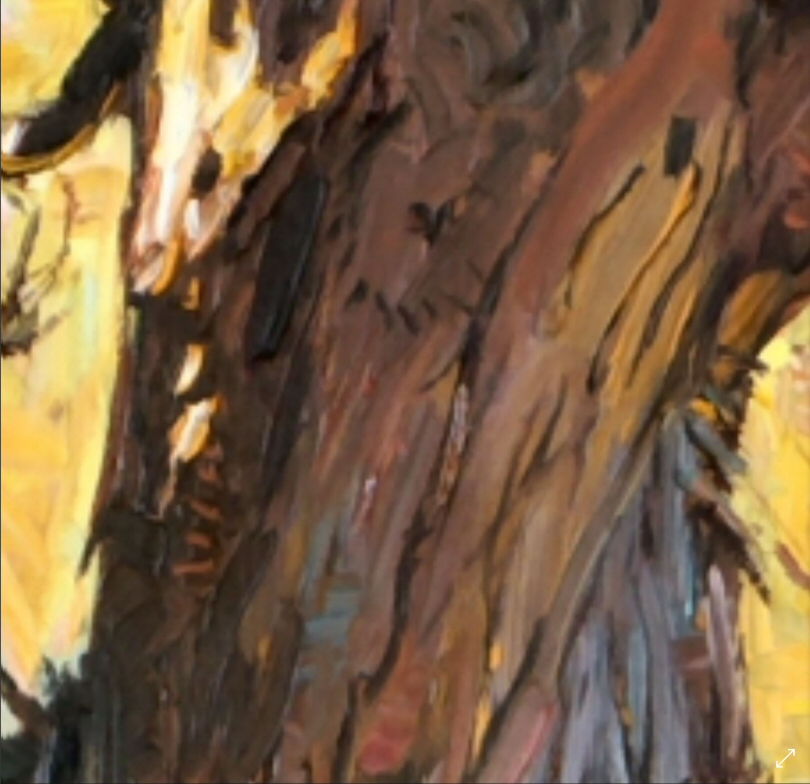
 A close up of October Gold (1929),
A close up of October Gold (1929),
shows the fine, blended style of stroke
where the trunk seems to glow with life.
As you can see from the images of the tree's trunk, the blending method RSW would evolve to lends for a much better representation of the translucent qualities of light for which Woodward was most often praised. What's more is, light also gives life to a painting. In capturing the truest sense of light and its nature, also brings alive and contributes to the naturalism RSW hoped to achieve without any embelishment of using hues and tonal qualities to imbue an atmospheric and/or emotional mood. That natural light, in and of itself, is enough.
Light and the use of it is an important facet of Woodward's compositions. In one review of RSW's work, the reviewer questioned whether Woodward's focus on the natural and ordinary light of daytime was the result of his limited abilities and he reasoned that maybe because of his difficulites, Woodward was restricted to that sort of schedule. However, when considering the argument, it does not make much sense. If RSW wished to capture the atmospheric glow of the rising sun, he would surely set his clock to wake in enough time to capture it. What holds more true to Woodward's focus on the natural light of daytime is best explained by way of a letter he wrote a friend during his time at Bradley, prior to his accident, he wrote:
"Are you where you can see the sunsets Helen? And do you ever notice the sky at the north and south? It's always vastly more delightful in color. Last night the west blazed a brilliant red between dark blue clouds a most hideous combination, but one which Mrs. Bourland pugnaciously upheld, because it was in the sky; she insisted that whatever was in the sky and hence, what man had not touched, God made perfect. But no, Helen, red and blue never - the green, greys, violets and blues of the northern and southern horizons at sunset time are immensely more pleasing."
Woodward to friend Helen Ives Schermerhorn as a student at Bradley Polytechnic Institute
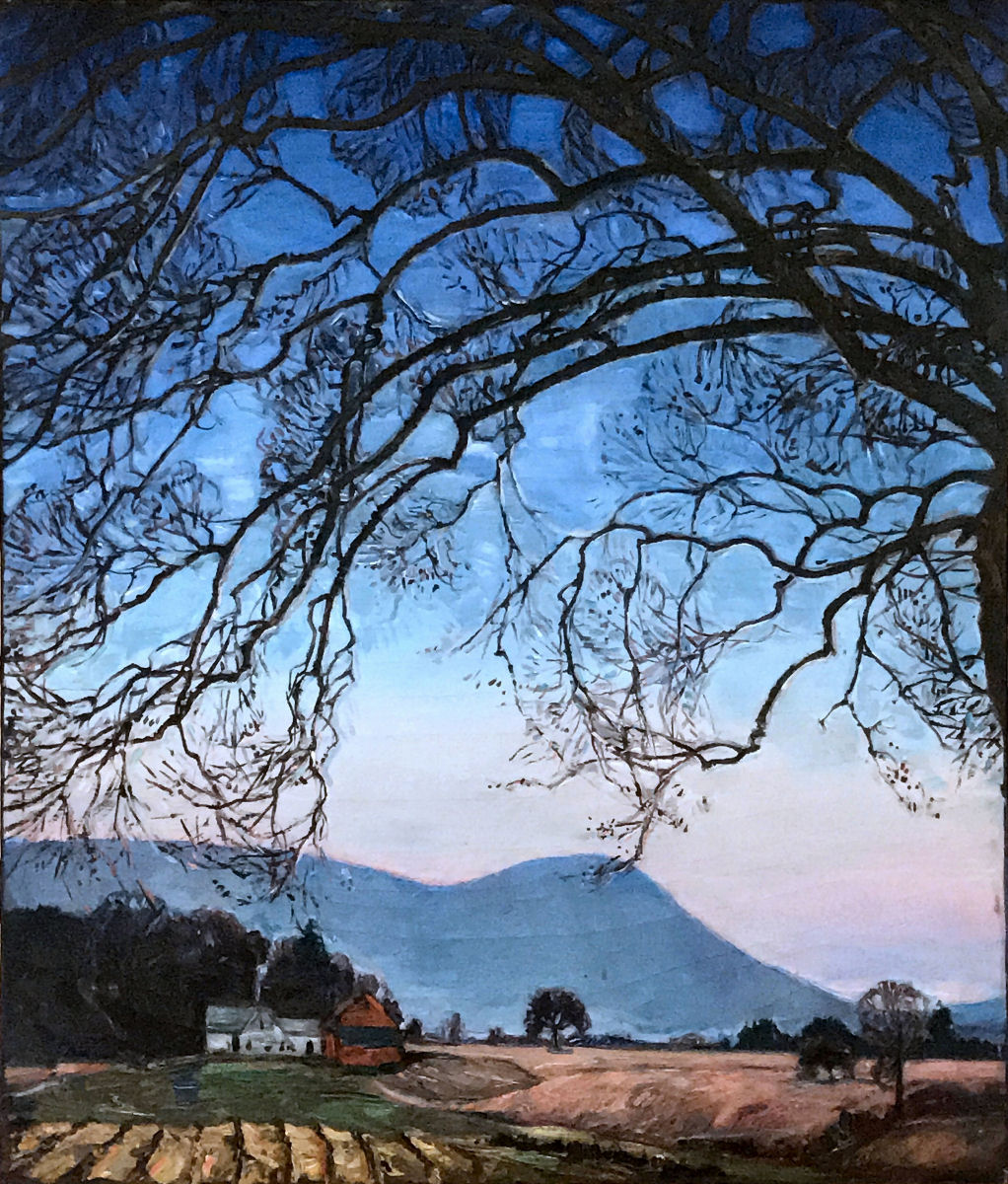
 Unnamed: From Under the Studio Tree
Unnamed: From Under the Studio Tree
of
Purinton Hill, painted between 1931- '35
from under the tree in front of the 'Little Shop'
studio, facing east, shortly before dusk.
Woodward rarely painted the eastern or western skys of sunsets or rises (with the exception of Great Faith in God Alone which was used in an Illumination and required an atmospheric and emotional response). Even his atmospheric moonlit Redgate paintings, predominantly faced north and used the indirect glow of the moon shining through the woods. There are some exceptions, such as, Silent Evening and Tranquility and the only painting for which the moon actually appears is the Beech Tree painting The Evening Moon.
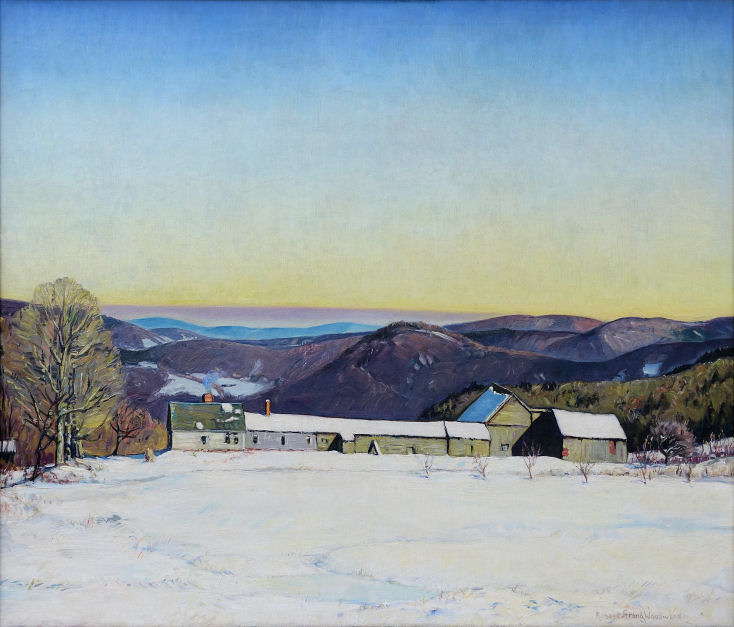
 Courage and Peace (winter 1931- '32) the
Courage and Peace (winter 1931- '32) the
Carter Farm on Avery Road (Buckland) with
Purinton Hill behind it, facing north, possibly
just after sunrise. A rarity for RSW.
The more we learn, the more we realize these directional perspectives are more than just preferences. Woodward is quite serious about utilizing the light from the north to frame his works in the most favorable and natural light. Yes, God does make perfect the magnificicient array of colors in all directions. They are all natural, untouched by man. However, the most accurate representation of the color itself is found in the cool tones and hues of the northern and southern southern skies. We believe it is more than coincidental that the same can be said of pastels; that they are the truest representation of a color of all mediums of painting.
We did our homework. We examined every image we had of Woodward's work to see if we could determine the direction he is facing. We found only a handful of paintings he faced east or west. In most cases, when we can determine direction to a satisfactory confidence, he often had the southern sky to his back painting the northern sky. There is one exception he made. His Heath Pasture Studio faced southeast toward the Buckland Hills to the south. Most of the Beech Tree paintings are facing east. However, the Heath Pasture, on Burnt Hill, represents a transcendental perspective to Woodward and thus the rising sun in the east holds to his intent for Burnt Hill is thus, the sole exception.
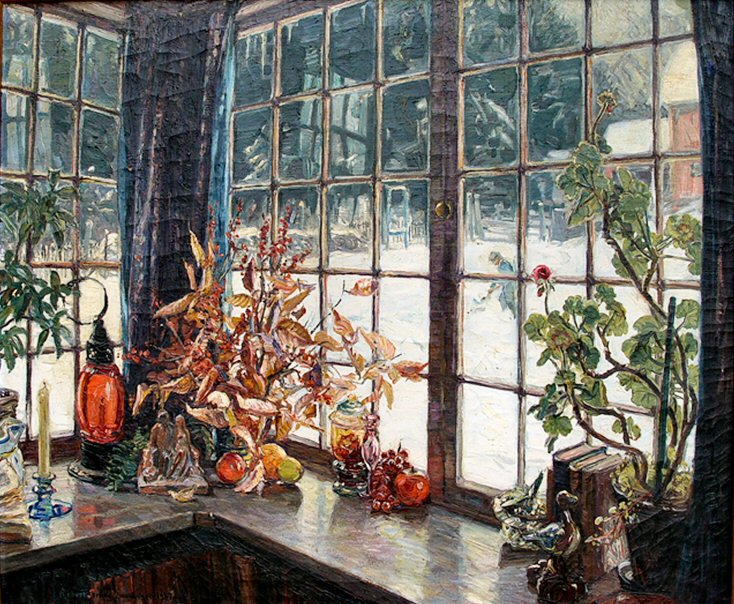
 My Winter Shelf, 1926, old style.
My Winter Shelf, 1926, old style.
A much better example because the image is in
color you can still see the impasti-style in this
painting. Woodward makes a second wave of
Window Pictures between 1927 and '29 but
we do not have an actual photograph of them.
Speaking of Redgate paintings, we have recently discovered that these paintings have a strong relationship to Woodward's Window Picture paintings. This becomes important to Woodward's shift from the heavy impasti use of paint to the blended technique. In 1925, Woodward paints his first professional "Window Picture" paintings beginning with, The Window; A Still Life and Winter Scene.
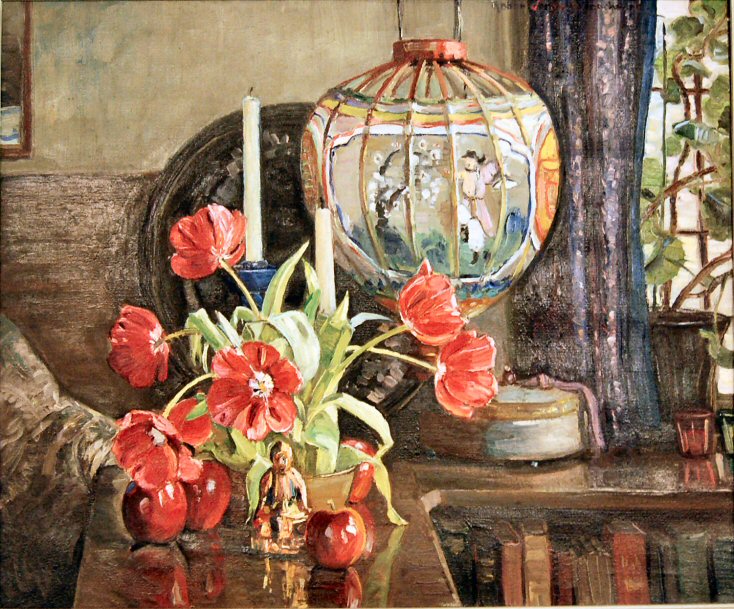
 Open Tulips,1931, new style.
Open Tulips,1931, new style.
The second wave of Window Pictures from
Hiram are unsuitable for comparision. However,
this still life from 1931 shows a considerable
difference in technique. Even the coloring is
softer. This is much less impressionistic.
The importance is that Woodward uses his most intimate moments, times when he is surely alone with his thoughts, to work from his stoop or studio. Redgate did not have a window to paint from so he does so from his front or back doors. By the time he is in his Hiram Woodward Place he has fashioned a studio exactly to his liking. The studio has a large, picturesque corner window with a north-facing artist window just like his Southwick Place and he makes use of the view to paint in the warmth of the studios.
Woodward is clearly moving away from the more impressionistic impasti style closer to a style that best reflects his personal preferences again. Without going too realistic, the artist makes his home in the middle. This style of painting, between impressionism and realism is called "representative." It is a style more suitable to the tenets of naturalism for which Woodward strongly subscribes. Between 1927 and 1931 is the period of time Woodward makes the commitment to paint in a style more suited to his values.
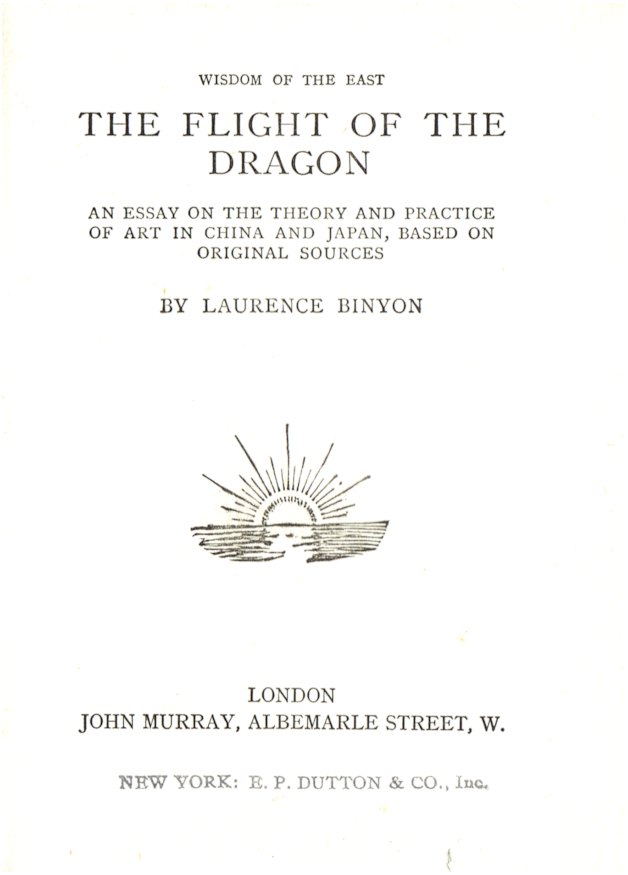
 Paste-down jacket page
Paste-down jacket page
In the East there are six "canons of art" prescribed to qualify as true artwork. The second canon is called, "rendering of bones," in reference to the early use of bone in writing and drawing. This is the artful mastery of the brush to render, "[the] anatomical structure by means of the brush." There is another coincidence during this time of transition for Woodward. In his collection of books left in his Southwick Studio is a book, The Flight of the Dragon written by Lawrence Binyon. It is a comparative essay of the Eastern and Western aesthetic first published in 1911. Woodward's version of the book is the 1927 edition. Woodward heavily marked and noted this book in its margins. The third of six canons is, "The drawing of forms which answer to natural forms," correllating to the influence of naturalism. In fact, if you examine all six canons, Woodward meets them all! But that is another essay for another time.
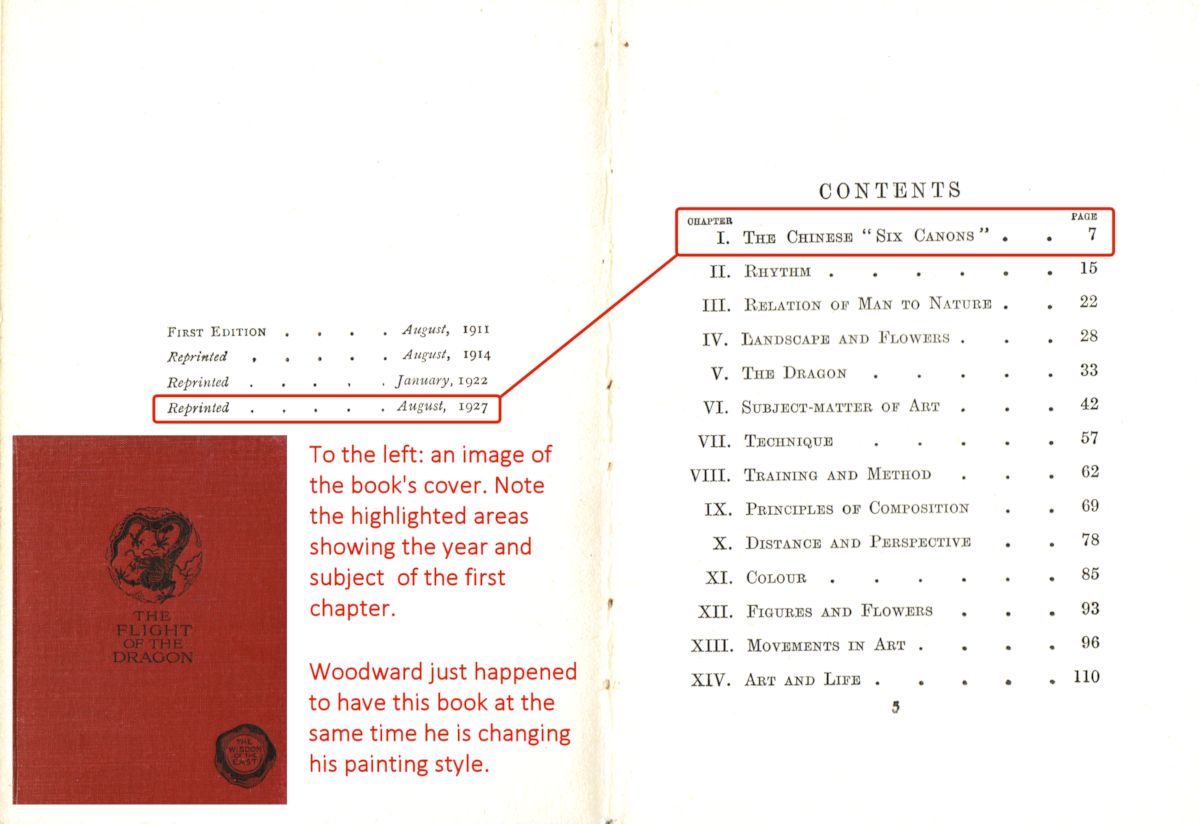
 Fight of the Dragon- Table of Contents
Fight of the Dragon- Table of Contents
Proin sollicitudin eget erat vel varius. Suspendisse sit amet mi vestibulum, malesuada neque sed, eleifend magna. Etiam quis dolor quis mi condimentum pulvinar quis fringilla arcu. Aenean id ornare velit. Sed eget varius purus. Suspendisse hendrerit pharetra tempus. Suspendisse potenti. Nunc neque odio, malesuada id maximus ut, cursus at lectus. Integer ac hendrerit ante. Duis ut urna in velit elementum rutrum sit amet at tellus. Mauris consequat, tellus sit amet pulvinar hendrerit, ex nulla egestas arcu, convallis varius sed neque.
Donec turpis urna, consequat eget accumsan id, tincidunt in sapien. Aliquam imperdiet risus in tortor suscipit, sed malesuada ligula consequat. Nam feugiat viverra quam id sagittis. Curabitur egestas vel metus ornare fermentum. Phasellus mattis, nulla vitae condimentum fermentum, nisi diam dapibus nunc, at consectetur est felis posuere eros. Suspendisse potenti. Vestibulum sollicitudin mollis ipsum, vitae egestas nisl tempus sed. Proin vel nulla leo. Morbi fringilla porta dui eu scelerisque. Nunc non lobortis nulla.

